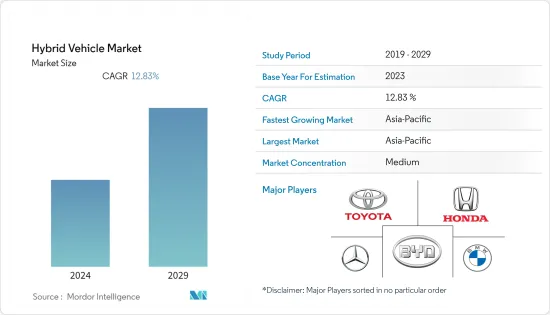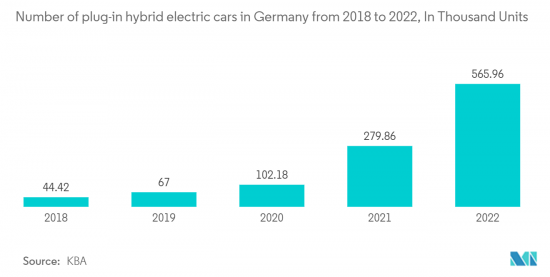 |
市場調查報告書
商品編碼
1403847
混合動力汽車:市場佔有率分析、產業趨勢與統計、2024年至2029年成長預測Hybrid Vehicle - Market Share Analysis, Industry Trends & Statistics, Growth Forecasts 2024 - 2029 |
||||||
※ 本網頁內容可能與最新版本有所差異。詳細情況請與我們聯繫。
混合動力汽車市場規模為2,317.7億美元,預計在預測期內將達到4,783.3億美元,複合年成長率為12.83%。

主要亮點
- COVID-19 大流行對混合動力汽車市場產生了積極影響。 COVID-19 提高了環保意識,這種擔憂現在反映在對更永續的電動車和混合的購買意願中。由於製造商計劃推出新型號以吸引客戶,因此預計預測期將樂觀。例如,澳洲豐田公司於 2022 年 11 月宣布對其廣受歡迎的Corolla掀背車和轎車系列進行多項更新,包括豐田連網型服務功能和最新一代混合動力傳動系統。
- 從長遠來看,制定嚴格的排放和燃油經濟性法規以及政府鼓勵購買和採用混合汽車的激勵措施是推動市場成長的關鍵因素。此外,隨著各國政府採取嚴格的監管和獎勵措施,以及加強建設電動車公共充電站,混合汽車市場預計將出現高速成長。
- 例如,2022年2月,印度政府表示,2023年混合和電動車早期採用和製造(FAME)計劃下的補貼預計為29.8億印度盧比(3.51億美元),是印度政府的3.5倍多。本財政年度的撥款為80 億印度盧比(9,650 萬美元),約為2021 財政年度撥款的九倍。
- 亞太地區混合動力汽車市場預計在預測期內將呈現高成長率。該地區市場的成長得益於中國、印度、日本和韓國混合汽車銷量的增加。亞太地區是混合動力汽車市場的主要企業,如比亞迪、豐田、日產、本田、起亞、現代等,他們的積極進入該領域為該市場創造了良好的環境。
- 例如,2022年11月:起亞中國在進博會上參展了小型純電動SUV“EV6”,並宣布將於2023年在中國上市。此外,起亞計畫在2026年在中國陸續推出五款混合型,首先是第五代Sportage緊湊型SUV的HEV車型。
混合車市場趨勢
政府補貼和政策不斷增加推動市場
- 世界各國政府為購買電動車和混合汽車的客戶提供許多補貼(退稅和獎勵)。例如
- 2022年11月,中國工業和資訊化部在其官方網站上公佈了《免徵車輛購置稅的新能源車型目錄》。入選的插電式混合型包括14款小客車(包括奇瑞大神和長城汽車摩卡PHEV)、3輛公車、4輛卡車和8輛特種車。
- 巴西、印度和墨西哥等新興國家對混合的需求不斷增加,這些國家的廢氣法規非常嚴格,對低排放和零排放氣體汽車的需求也增加。巴西政府對混合提供稅收減免,包括插電式混合、混合電動車和CNG混合。同樣,印度政府宣布將著名的 FAME II 計劃延長至 2024 年,以促進全國範圍內的電動出行。各大主要企業也計劃參與該國的 Eco-Drive。例如,2022年3月,豐田汽車確認計畫擴大在印度生態旅遊領域的參與,並準備在未來幾年推出多款混合。第一批產品將在當地生產,並將於明年推出市場。
- 美國和歐洲政府也致力於降低排放氣體法規,以減少溫室氣體排放並提高車輛燃油效率。例如,美國運輸部製定了汽車企業平均燃油經濟性 (CAFE) 標準。英國承諾在2050年實現淨零排放,並提案2035年禁止銷售所有污染汽車。德國的目標是到年終年底將溫室氣體排放減少40%,到年終減少55%,到2050年終減少至95%,以支持市場成長。
- 在沿岸地區,電動車和混合動力汽車運輸正在變得普及,特別是在以色列、阿曼、約旦、沙烏地阿拉伯和阿拉伯聯合大公國。例如,根據杜拜計程車管理局的2021-2023年戰略計劃,杜拜道路和運輸管理局(RTA)宣布已簽署採購2,219輛新車的契約,以補充杜拜計程車管理局的車隊。此次採購包括 1,775 輛混合汽車,使我們車隊的混合汽車持有達到 4,105 輛。

中國在開拓亞太混合汽車市場中發揮關鍵作用
- 亞太地區混合汽車市場預計在預測期內將成長。中國、日本和韓國對混合汽車的需求不斷成長正在推動該地區的市場成長。
- 由於其巨大的生產能力和消費需求,中國是全球混合電動車市場的主要參與企業。疫情過後,中國經濟成長動能電動車,混合和插電混合的需求開始呈現正面趨勢。
- 例如,2022年10月新能源小客車批發量為67.6萬輛,與前一年同期比較成長85.8%。純電動車(BEV)與前一年同期比較50.8萬輛,插混合電動車(PHEV)年增69.6%至50.8萬輛,插電式混合動力車(PHEV)與前一年同期比較16.7萬輛,內燃機混合小客車年增9 %與前一年同期比較,總數為7,300台。
- 中國政府為購買電動車和混合汽車的客戶提供許多補貼(稅收減免和獎勵)。中國政府最近延長了原定於 2020 年到期的免稅和補貼,並暗示新的投資從長遠來看可能進一步提振中國的混合電動車市場。訂定了支持新能源汽車 (NEV) 行業的措施,受到-19疫情的嚴重打擊。
- 預測期內,Delta的廣州、東莞、珠海、佛山、中山以及南京、杭州、陝西、山東等中國30多個城市計劃實現公共運輸100%電氣化,混合公車也有可能增加採用。上述因素以及新興市場的開拓預計將有助於中國脫穎而出,成為製造商獨特的投資目的地,並在預測期內對混合動力汽車市場的整體成長發揮關鍵作用。
混合車產業概況
進入混合汽車市場的主要企業包括福特汽車公司、通用汽車公司、本田汽車、戴姆勒公司和大眾汽車公司,它們計劃加強產品系列併在混合汽車市場取得技術突破。例如
三菱汽車公司宣布將於 2022 年 11 月在加拿大和美國推出新款Outlander跨界 SUV 的插電式混合(PHEV) 車型。它提供了SUV在各種天氣和路況下所應有的實用性和強勁駕駛性能,並提供了只有電動車才能提供的安全駕駛。
2022年10月,大發汽車宣布打算在2023年秋季推出一款混合小型貨車。緊湊型混合(HV)「Rocky」採用的混合系統針對輕型車進行了顯著改進,實現了超過30公里/公升(WLTC模式)的燃油效率,處於輕型車級別的頂級水平。
其他福利:
- Excel 格式的市場預測 (ME) 表
- 3 個月分析師支持
目錄
第1章簡介
- 調查先決條件
- 調查範圍
第2章調查方法
第3章執行摘要
第4章市場動態
- 市場促進因素
- 燃油效率法規和政府獎勵
- 市場抑制因素
- 純電動車需求不斷成長
- 產業吸引力-波特五力分析
- 供應商的議價能力
- 消費者議價能力
- 新進入者的威脅
- 替代品的威脅
- 競爭公司之間敵對關係的強度
第5章市場區隔(市場規模:美元)
- 按混合型分類
- 微混合
- 輕度混合
- 全混合
- 插電式混合
- 按車型
- 小客車
- 商用車
- 按地區
- 北美洲
- 美國
- 加拿大
- 北美其他地區
- 歐洲
- 德國
- 英國
- 法國
- 義大利
- 挪威
- 荷蘭
- 歐洲其他地區
- 亞太地區
- 中國
- 印度
- 日本
- 韓國
- 其他亞太地區
- 世界其他地區 中東/非洲
- 南美洲
- 中東/非洲
- 北美洲
第6章競爭形勢
- 供應商市場佔有率
- 公司簡介
- Toyota Motor Corporation
- Nissan Motor Co. Ltd
- Honda Motor company Ltd
- Hyundai Motor Company
- Kia Motors Corporation
- Volvo Group
- Volkswagen Group
- BMW AG
- Ford Motor Company
- Mercedes-Benz Group
- BYD Co. Ltd
第7章 市場機會及未來趨勢
- 混合動力引擎技術開發

The hybrid vehicle market was valued at USD 231.77 billion, and it is expected to reach USD 478.33 billion by registering a CAGR of 12.83% during the forecast period.
Key Highlights
- The COVID-19 pandemic positively impacted the hybrid vehicle market as the pandemic has crystallized attitudes toward the environment by revealing cleaner air and lower pollution levels during the lockdown. COVID-19 increased their environmental awareness, and these concerns are now reflected in intentions to purchase more sustainable electric and hybrid vehicles. The forecast period is expected to be optimistic as manufacturers plan to launch new models to attract customers. For instance, in November 2022, Toyota Australia announced several updates to its popular Corolla hatch and sedan lineups, including Toyota Connected Services functionality and the latest-generation hybrid powertrain.
- Over the long term, some of the major factors driving the market's growth are the enactment of stringent emission and fuel economy norms and government incentives for promoting the purchase and adoption of hybrid vehicles. Additionally, with governments taking stringent actions in the form of regulation and incentives, along with the increased initiatives for the provision of public charging stations for electric vehicles, the hybrid vehicle market is expected to grow at a high rate.
- For instance, in February 2022, According to the government of India, the subsidy under the Faster Adoption and Manufacturing of Hybrid and Electric Vehicles (FAME) program for fiscal 2023 is expected to be INR 2,908 crore (USD 351 million), which is more than three-and-a-half times the allocation of INR 800 crore (USD 96.5 million) for this fiscal year and nearly nine times the allocation for FY21.
- The Asia-Pacific hybrid vehicles market is expected to witness a high growth rate during the forecast period. The market growth in this region can be attributed to the increased sales of hybrid vehicles in China, India, Japan, and South Korea. As the Asia-Pacific region is home to major players in the hybrid vehicles market, such as BYD, Toyota, Nissan, Honda, Kia, and Hyundai, their active engagement in this segment creates a positive environment in the market.
- For instance, November 2022: Kia China announced that its EV6 compact battery electric SUV was on display at the CIIE and would be available in China in 2023. Kia will also launch 5 hybrid models in China in succession by 2026, beginning with the HEV model of the 5th generation Sportage compact SUV.
Hybrid Vehicle Market Trends
Rising Government Subsidies and Policies to Drive the Market
- Governments are offering many subsidies (tax rebates and incentives) for customers purchasing electric and hybrid vehicles globally. For instance,
- in November 2022, The Ministry of Industry and Information Technology (MIIT), China, published a "Catalog of New Energy Models Exempt from Vehicle Purchase Tax" on its official website. The plug-in hybrid models chosen include 14 passenger vehicles (such as Chery's Dasheng and Great Wall Motor's Mocha PHEV), three buses, four trucks, and eight specialty vehicles.
- Demand for hybrid vehicles is increasing in developing countries such as Brazil, India, and Mexico due to strict emission regulatory rules and a growing need for low or zero-emission vehicles. The Brazilian government is cutting taxes on hybrid vehicles such as plug-in hybrids, hybrid electric vehicles, and CNG hybrids. Similarly, the Indian government has announced that its well-known FAME II program will be extended until 2024 in order to promote electric mobility throughout the country. Major key players are also planning to participate in the country's green drive. For instance, in March 2022, Toyota Motor confirmed plans to increase its participation in India's green mobility segment, with the company preparing to launch a number of hybrid vehicles in the coming years. The first of these products, which will be manufactured locally, will hit the market next year.
- Governments in the United States and Europe are also focusing on lowering emission limits to reduce the greenhouse gas effect and improving vehicle fuel economy. For example, the US Department of Transportation has established Corporate Average Fuel Economy (CAFE) standards for vehicles. The United Kingdom committed to achieving net-zero emissions by 2050 and proposed a 2035 ban on selling all polluting vehicles. Germany intends to reduce greenhouse gas emissions by 40% by the end of 2020, 55% by the end of 2030, and up to 95% by the end of 2050, supporting market growth.
- In the Gulf region, electric and hybrid modes of transportation are gaining traction, particularly in Israel, Oman, Jordan, Saudi Arabia, and the United Arab Emirates. For example, In accordance with the Dubai Taxi Corporation's Strategic Plan 2021-2023, The Roads and Transport Authority (RTA) of Dubai has announced the signing of a contract for the procurement of 2,219 new vehicles to supplement the fleet of the Dubai Taxi Corporation. The new batch includes 1,775 hybrid vehicles, bringing the fleet's total number of hybrid vehicles to 4,105.

China to Play a Key Role in the Development of the Hybrid Vehicle Market in Asia Pacific
- The Asia-Pacific hybrid vehicle market is expected to grow during the forecast period. Increased demand for hybrid vehicles in China, Japan, and South Korea are driving market growth in this region.
- China is a significant player in the global hybrid electric vehicle market due to its significant production capabilities and consumer demand. Following the pandemic, China gained momentum, and demand for hybrid and plug-in hybrid electric vehicles started seeing positive trends.
- For instance, in October 2022, The wholesale volume of NEV passenger cars was 676,000 units, up 85.8% year on year. Battery electric vehicle (BEV) volumes increased by 69.6% year on year to 508,000 units; plug-in hybrid electric vehicle (PHEV) volumes increased by 161.6% year on year to 167,000 units, and ICE-powered hybrid passenger vehicle volumes increased by 9% year on year to 67,362 units.
- The Chinese government provides numerous subsidies (tax breaks and incentives) to customers who purchase electric and hybrid vehicles. The Chinese government recently introduced measures to support the new energy vehicle (NEV) industry, which was hard hit by the COVID-19 outbreak, by extending tax exemptions and subsidies that were set to expire by 2020 and hinting at new investments that could further boost the country's hybrid electric vehicle market in the long run.
- During the forecast period, the country may also see an increase in the adoption of hybrid electric buses, as more than 30 Chinese cities, including Guangzhou, Dongguan, Zhuhai, Foshan, and Zhongshan in the Pearl River Delta, as well as Nanjing, Hangzhou, Shaanxi, and Shandong, have made plans to achieve 100% electrified public transportation. All of the aforementioned factors and developments are expected to help China stand out as a unique destination for manufacturer investments and play a significant role in the overall growth of the hybrid vehicle market over the forecast period.
Hybrid Vehicle Industry Overview
Some of the key players operating in the hybrid vehicles market are Ford Motor Company, General Motors Company, Honda Motor Co., Ltd, Daimler AG, and Volkswagen AG, which are also planning to provide enhanced product portfolios and technological breakthroughs in the hybrid vehicles market. For instance,
In November 2022, Mitsubishi Motors Corporation announced that the plug-in hybrid electric vehicle (PHEV) model of the all-new Outlander crossover SUV would be available in Canada and the United States. The new model provides the practicality and powerful ride expected of an SUV in various weather and road conditions, a safe ride unique to an electrified vehicle.
In October 2022, Daihatsu Motor Co., Ltd intended to release a hybrid minivan in the fall of 2023. The series hybrid system used in the compact hybrid vehicle (HV) Rocky will be significantly improved for mini vehicles to achieve a fuel efficiency of 30 kilometers per liter (WLTC mode) or higher, which would be among the best in the micro-mini class.
Additional Benefits:
- The market estimate (ME) sheet in Excel format
- 3 months of analyst support
TABLE OF CONTENTS
1 INTRODUCTION
- 1.1 Study Assumptions
- 1.2 Scope of the Study
2 RESEARCH METHODOLOGY
3 EXECUTIVE SUMMARY
4 MARKET DYNAMICS
- 4.1 Market Drivers
- 4.1.1 Fuel Economy Norms and Government Incentives
- 4.2 Market Restraints
- 4.2.1 Growing Demand For Battery Electric Vehicles
- 4.3 Industry Attractiveness-Porter's Five Forces Analysis
- 4.3.1 Bargaining Power of Suppliers
- 4.3.2 Bargaining Power of Consumers
- 4.3.3 Threat of New Entrants
- 4.3.4 Threat of Substitute Products
- 4.3.5 Intensity of Competitive Rivalry
5 MARKET SEGMENTATION (Market Size in USD)
- 5.1 By Hybrid Vehicle Type
- 5.1.1 Micro-hybrid
- 5.1.2 Mild-hybrid
- 5.1.3 Full-hybrid
- 5.1.4 Plug-in Hybrid
- 5.2 By Vehicle Type
- 5.2.1 Passenger Cars
- 5.2.2 Commercial Vehicles
- 5.3 By Geography
- 5.3.1 North America
- 5.3.1.1 United states
- 5.3.1.2 Canada
- 5.3.1.3 Rest of North america
- 5.3.2 Europe
- 5.3.2.1 Germany
- 5.3.2.2 United Kingdom
- 5.3.2.3 France
- 5.3.2.4 Italy
- 5.3.2.5 Norway
- 5.3.2.6 Netherlands
- 5.3.2.7 Rest of Europe
- 5.3.3 Asia-Pacific
- 5.3.3.1 China
- 5.3.3.2 India
- 5.3.3.3 Japan
- 5.3.3.4 South Korea
- 5.3.3.5 Rest of Asia-Pacific
- 5.3.4 Rest of the World
- 5.3.4.1 South America
- 5.3.4.2 Middle-East and Africa
- 5.3.1 North America
6 COMPETITIVE LANDSCAPE
- 6.1 Vendor Market Share**
- 6.2 Company Profiles*
- 6.2.1 Toyota Motor Corporation
- 6.2.2 Nissan Motor Co. Ltd
- 6.2.3 Honda Motor company Ltd
- 6.2.4 Hyundai Motor Company
- 6.2.5 Kia Motors Corporation
- 6.2.6 Volvo Group
- 6.2.7 Volkswagen Group
- 6.2.8 BMW AG
- 6.2.9 Ford Motor Company
- 6.2.10 Mercedes-Benz Group
- 6.2.11 BYD Co. Ltd
7 MARKET OPPORTUNITIES AND FUTURE TRENDS
- 7.1 Technological Development In Hybrid Engine












